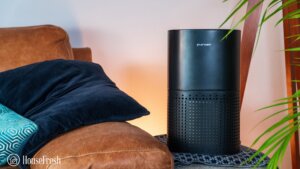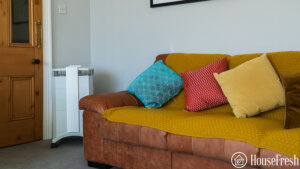The Vesync Corporation launched the Levoit brand in 2016. Since then, Levoit has become a game-changer in the air purifiers market. The Core series presented consumers with affordable prices, innovation and everyday needs in mind. In 2023, they launched the EverestAir, a unit that quickly made it to the top of plenty of our Best Guides due to its performance and surprising air cleaning speed.
Now, back to the Core 300. Released in 2019, it quickly became a popular option in the context of the COVID-19 pandemic. It reached the #1 position for Amazon sales in Air Purifiers that year. And even though eradicating viruses from our homes may not be the drive it was a couple of years ago, air pollution is still a rising concern for many of us.
Fast forward to 2024, the air purifying industry has evolved significantly. Many new brands and models have flooded the market, some delivering a high-performance and smart features combo (such as the Shark HP102), some even competing directly with the Core 300 and showing amazing results (hello Winix A230/A231), others turning out to be no more than a disappointing overpromise. Yet, the Levoit Core 300 remains a best-selling unit to this day.
True, it has no smart features or auto mode. But the legendary Levoit Core 300 set the benchmark for most budget air purifiers available today. It still is a straightforward, trustworthy air purifier that can do an outstanding job for one of the lowest price tags available.
As a great entry-level air purifier, the Core 300 is solid and reliable to date.
The lowdown on the Levoit Core 300

So, let’s get straight to it. These are, in a nutshell, the strengths and weaknesses we see on the Levoit Core 300 after putting it to the test:
What we really like
What we think could be better
The specifications
For less than $100, the Core 300 has a solid CADR of 145 CFM. This has been the best price-to-CADR ratio in the market for years, although lately, new units like the Winix A230 or the TaoTronics TT-AP003 have surpassed the Core 300 CARD for less than $80.
It still stands its ground as one of the best budget air purifiers we have tested, with affordable genuine filter replacements and excellent performance of pure mechanical filtration — both on paper and in our hands-on testing.
| HouseFresh Rating: | ★★★★☆ |
| Time to clean our 728 cubic feet test room (with the device running at top speed): | 40 minutes |
| Air purifier technology: | Pre-filter, non-HEPA grade particle filter, and activated carbon pellets |
| Recommended room size (4.8 air changes per hour): | 219 sq. ft. |
| Clean air delivery rate (CADR): | Dust: 131 cfm Smoke: 126 cfm Pollen: 154 cfm |
| Dimensions (in inches / in cm): | 8.7L x 8.7W x 14.2H inches (22L x 22W x 36H cm) |
| Weight (in pounds / in kg): | 7.5 lbs (3.4 kg) |
| Filter life: | 6 – 8 months |
| Noise level in decibels (measured from 3 ft. away with a sound level meter): | Speed 1: 37.1 dB Speed 2: 48.5 dB Speed 3: 50.2 dB Top speed: 54.5 dB |
| Electricity consumption in watts (recorded with an electricity usage monitor): | Standby mode: 0.1 watts Sleep mode: 17.3 watts Speed 1: 19.7 watts Speed 2: 24 watts Top speed: 35.5 watts |
| Manufacturer’s warranty: | 2 years |
| Estimated energy consumption: | $47.30 |
| Country of manufacture: | China |
Compact, smooth and easy to use
The cylindrical body and rounded edges of the Core 300 allow for a small floor footprint and user-friendly controls.

With a cleaning power suited for 200 sq. ft. spaces, such as average-sized bedrooms, home offices or small kitchens, it only makes sense that this unit is petite enough to fit cozily on desks, kitchen counters or night tables. It doesn’t take up much space, so it can be placed near the source of pollutants without interrupting your activity or needing much setup rearrangement. Besides, weighing only 7.5 lbs, it’s easy to move around.
The tubular design is the same as most of the Core series. With the 360º air intake, all the way around the bottom of the unit, you get air flowing in from all sides and coming out clean at the top. Enhanced by the cylindrical shape, Levoit’s Vortex Air technology produces a swirling airflow to maximize the air circulation on all fanspeeds.

Among Levoit’s wide range of air purifiers, the Core 300 stands as the middle-sized unit, equal in dimensions to the Core 300S and only slightly bigger than the 200S and the Mini — both suited for smaller spaces.
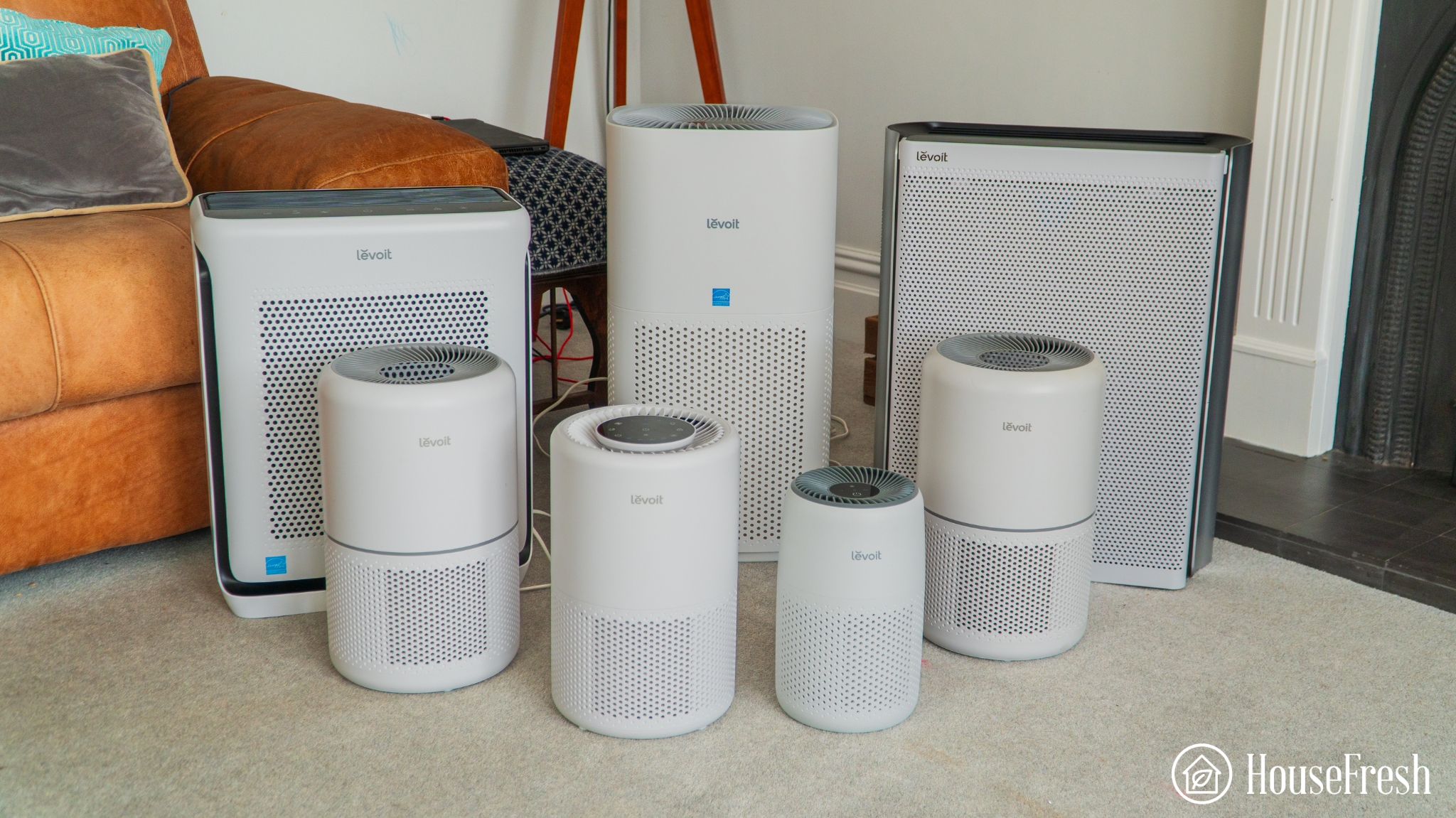
It’s also very similar in size to the Winix A230/A231, the new contender in town, with an almost identical floor footprint. The Core 300 is slightly taller and somewhat less organic than the conic Winix. On the other hand, it’s entirely white, which I like because it blends easily into the room, allowing for a more unobtrusive presence.

The control panel is a strong point for Levoit.
It’s a neat white-over-black touchscreen, very responsive yet not overly sensitive. There’s no onboard sensors on the Core 300, so the controls could feel a tad basic, but it’s far from it. It’s one of the simplest, most straightforward units that doesn’t lose perspective on what users need.
Let me explain. On the Core 300 control panel, you’ll see the wheel of self-explanatory icons: the on/off button, a fan button to navigate through three different fan speeds, a lock button that will come in handy for those placing the unit in kids’ rooms, a filter replacement light that will turn red when it needs replacement, a timer to set the unit to run for 2, 4, 6 or 8 hours, a sleep mode that lowers the fan to the minimum, and a lights-off button that will be a blessing for those who use this unit in the bedroom.

With no smart features onboard, such as app support or auto mode, the Core 300 is not a unit for technophiles. It’s ideal for those seeking a simple air purifier with an uncomplicated setup and straightforward controls.
It does come with a built-in memory, so if you unplug the unit to move it to another room, it will remember your last setting as soon as you plug it back in. This may seem trivial, but it’s actually quite helpful, and many brands have been cutting down on costs to make more accessible yet powerful units; the memory is something we’ve often seen removed.
Plus, there’s no worrying about opaque data sharing consents, which is not just an issue with Vesync’s app. Most apps have never-ending privacy policies many of us never read and usually request access to our phone camera or location, although we’re often unaware of the many ways big companies use that information.
A comprehensive three-stage filtration system
An ideal filter for everyday air pollutants.
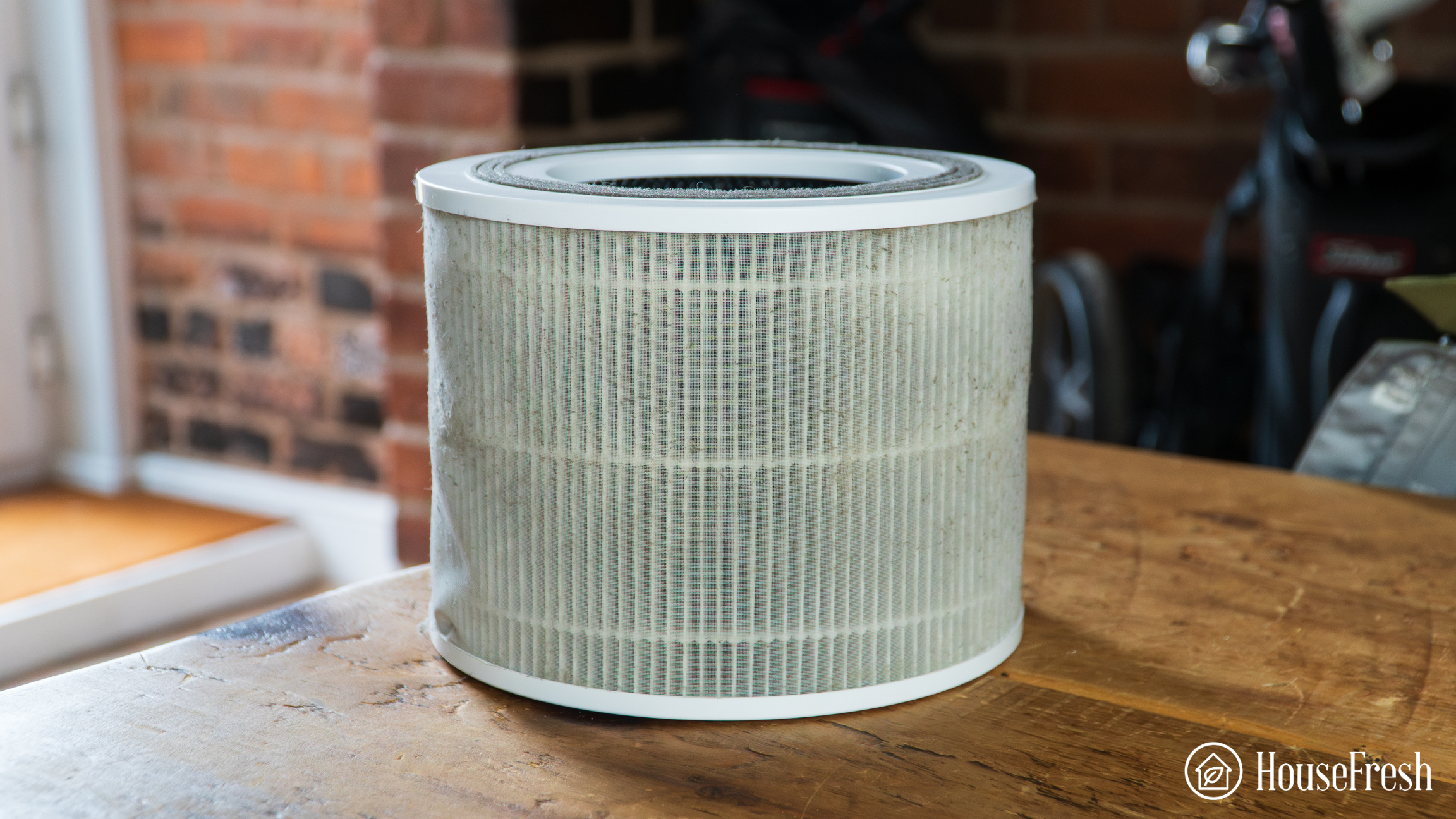
Since 2023, Levoit decided to remove all mentions of HEPA filters from the marketing materials for many of their air purifiers, including the Core series and the EveresAir. While other units, such as the Vital 100S and 200S, are advertised as featuring HEPA filters, we haven’t seen any third-party testing yet.
Despite this issue, which can no doubt create distrust in the brand and the filter’s efficiency, at HouseFresh, we believe in hands-on testing. And our results show that the Core 300 filter performs really well.
I’ll get to the cleaning efficiency in a bit, but for now, let me say the filter features all three stages that make a robust filtration system:
- A pre-filter for larger particles. It’s the outer nylon layer that traps hair, fibers, dust and lint. The pre-filter is not removable like in other Levoit units, but it can be vacuumed to extend the primary filter’s life.
- A main filter. The dense fiber maze is designed to capture airborne fine particles such as pollen, dust, mold spores, dander and other microscopic pollutants or allergens.
- An activated carbon filter with granular activated carbon —a nice detail compared to other impregnated fabric carbon filters. The charcoal traps VOCs and odors on its surface by adsorption (similar but not entirely the same as absorption), so the higher amount of carbon a filter has, the more gasses and odors it will be able to adsorb.
There are four genuine Levoit filters to choose from, the main difference being the amount of carbon. The Original filter contains between 40 and 50 grams, while the Pet Allergy, Toxin Absorber and Smoke Remover filters have 90 grams. These also come with Levoit’s ARC Formula, which breaks down particles to make the activated carbon last longer.
But it’s worth noting that this amount of charcoal won’t be enough if you have severe issues with toxic gasses or fumes. Instead, I’d suggest you check our best air purifiers for VOCs guide.
Replacing the filter on the Core 300 is simply effortless.
The access to the filter compartment is at the bottom of the unit. The lid can be opened by twisting counterclockwise and closed clockwise. In three easy steps, the Core 300 will be ready to start cleaning the air again:
- Unscroll the bottom cover of the device.
- Remove the old (and dusty) filter; have a bag ready to dispose of it with minimal particles reentering your home.
- Place the new one in its place and then put the cap back on.
Or else, see how easily it is done in this video:
Removing the filter from the unit is fairly easy, and it can be done in three simple steps:
All new air purifiers come with their filter packed in plastic wrapping. It’s common practice in the industry to protect it during storage and delivery so you can enjoy its full filtering power.
If it’s your first air purifier, you may not know about the wrapping and plan to plug and run it right away. So here’s a friendly heads up: remember to remove the filter’s wrapping before turning on your new Core 300.
The Core 300 cleared our test room in 40 minutes
For a small-to-mid-ranged air purifier for under $100, we are still impressed with the Core 300’s results.
- In our home lab of 728 cubic ft, we light an incense stick to generate particle pollution and VOCs.
- We set up our trusted Purpleair Indoor Sensor with the latest Bosch gas sensor to track levels of PM1ug/m3, PM2.5ug/m3 and PM10ug/m3 and VOCs in the air.

- We switch the air purifier to its highest speed and measure how long it takes to get our room air quality down to PM1 level to 0.
- We use an energy meter to measure precisely how much electricity is used when running the unit at the lowest and highest fan speed settings.
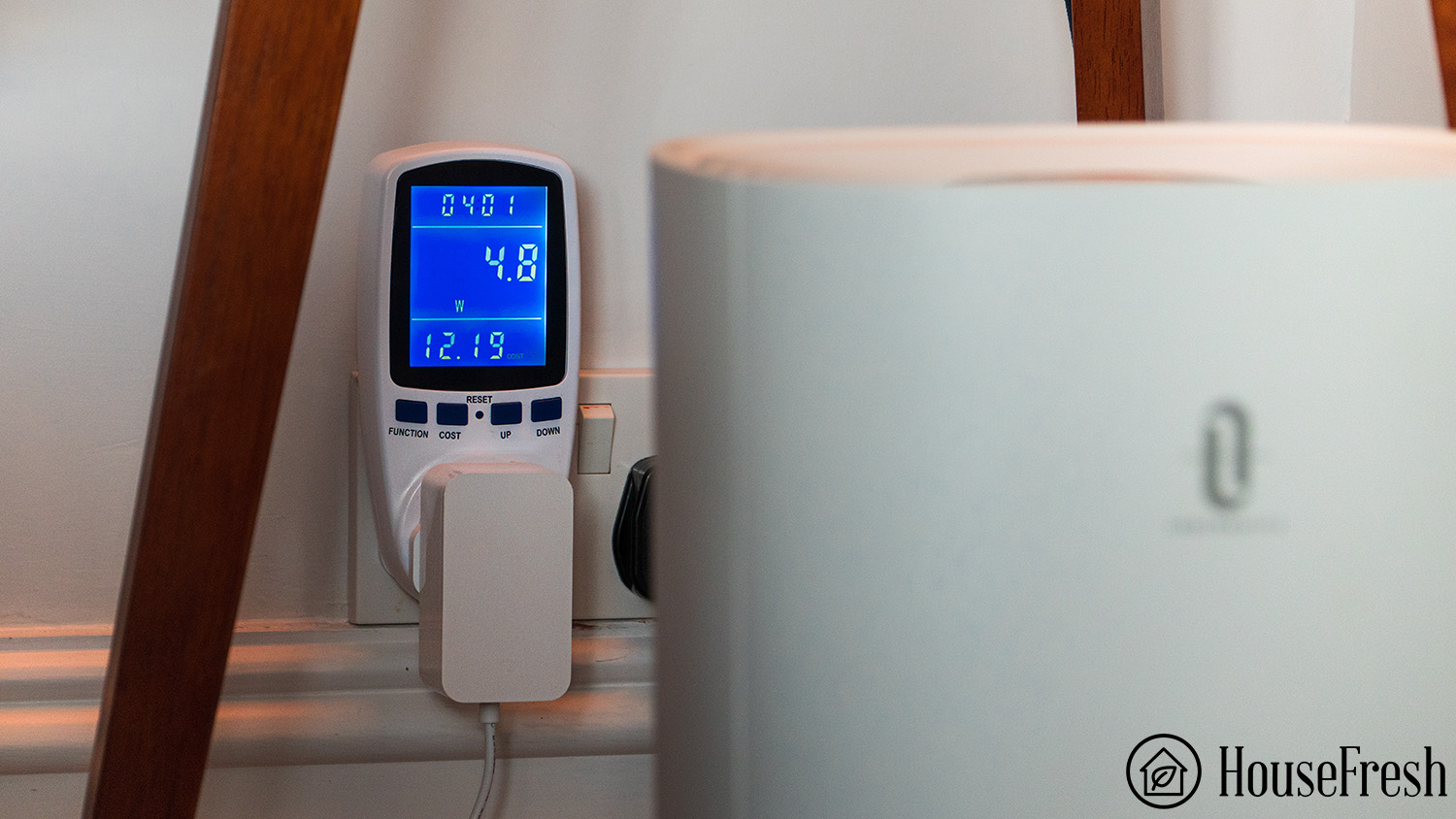
- We track sound levels emitted by the air purifier at different fan speeds with the help of a commercial sound meter.

The Core 300 has a CADR (clean air delivery rate) of 140 CFM for smoke, 141 CFM for dust and 145 CFM for pollen, according to the Energy Star rating.

While it’s becoming common practice to have third-party testing —and it’s actually reassuring, especially after Levoit’s HEPA / not HEPA filters issue— we still carry out our own first-hand evaluation process.
We test all the units in the same 728 cubic ft office, so we are able to evaluate every air purifier’s cleaning performance and speed but also compare results across all units.
With the help of our Purpleair indoor sensor, we measured how long it took the Core 300 to remove all the PM1.0ug/m3, PM2.5ug/m3 and PM10.0 ug/m3 produced by incense smoke.
The results speak for themselves:
Air cleaning performance test results
Needing only 40 minutes to remove all particulate matter from our home lab, it took the Core 300 just one minute longer compared to the smart and more expensive Levoit Core 300S.
This is also only two minutes behind the Shark HP102 (38 minutes) —a unit that quickly became a favorite at HouseFresh— and almost ten minutes quicker than the $650 Dyson TP07 (49 minutes).
It’s only fair to say that there are newer units for small or mid-sized rooms that can clean the air faster. And yet, for this value for money, the Core 300 is still among the best units we tested in 2023.
Noise levels test results
Whether you work from home or are shopping for an air purifier for the bedroom or study room, the noise levels are essential data to factor in.
All air purifiers produce a certain amount of noise; engineering hasn’t evolved to the point of creating completely silent fans and motors. We’ll probably get there sooner or later, but for now, knowing beforehand how loud a unit can be will help avoid unpleasant surprises.
That’s why this is the final step of our testing process, we measure every unit’s decibel (dB) output at the lowest and highest fan speeds. It is worth clarifying that we do this in a home environment and not a lab, so our measurements might be louder than the manufacturer’s because our noise level meter will pick up the hum of a fridge or a boiler in the background. We do this because we want to test how noisy air purifiers will be when used in the average home, aggregated on top of common household noise levels.
The Core 300 noise levels fall below the average decibels, emitting 37.1 dB in its most silent mode (sleep mode) and topping at 54.5 dB. For reference, Levoit’s marketing materials state 24 dB at the Core 300 lowest fan speed and 50dB at its highest fan speed.
This is how it compares to other units:
The Blueair 411+ tops the list as one of the quietest units we’ve tested, thanks to Blueair’s trademark HEPAsilent technology that combines mechanical (HEPA) filtration and ionization (electrically charging pollutants to make them weigh more and become easier to trap by the HEPE filter).
While the Core 300 is no match to the Blueair 411+ (17 dB), its filtration system is purely mechanical, with zero chemical by-products entering your space. It’s barely noticeable in sleep mode (24 dB) and I got used to the noise level of speed one pretty quickly.
It’s worth noting, though, that you’ll probably be running a small unit like this at the second or highest fan speed to make sure it actually cleans the air in your space —even if it’s a small room.
Compared to other units, the peak for noise output on this unit is not among the highest. However, bigger, more powerful air purifiers will be able to remove pollutants at lower fan speeds more efficiently.
But when it comes to sounds, words usually fall short. That’s why we recorded this video where you can hear the Core 300 first-hand at all its speeds.
The cost to run a Levoit Core 300: $67.83 per year
Even if it’s not the most energy-efficient air purifier, its annual costs are considerably low — a true reflection of the key selling point of the Core 300: a budget-friendly unit.
1. Electricity costs = $37.84 per year

Understanding the annual operating cost of an air purifier can be a deciding factor in narrowing down your preselection. We understand energy costs are not something to take lightly, especially when these are on the rise worldwide.
Besides, ideally, an air purifier should run continuously to achieve true, clean air. That being said, the Levoit Core 300 pulls 35.5 watts at maximum power. In more understandable terms, that means $37.84 per year or $0.13 a day. It’s unlikely you’ll run the unit at top fan speed 24/7, but it’s good to know the priceiest it can get.
Compared to other Levoit units, however, the Core 300 is not the most efficient energy-wise. With the Core 300S, the manufacturer managed to improve energy consumption to only 26 watts, while the 400S pulls no more than 24.5 watts, both at their highest fan speed. While the initial price on these two units is higher, it’s worth noting they are less power-hungry.
2. Filter costs = $29.99 per year

The second fixed cost to consider is the filters, which, in the case of the Core 300, are replaced every six to eight months.
When it comes to filters, Levoit realized that if they wanted to keep leading the budget air purifiers game, they needed to lower the costs. The first genuine replacement filters we got for the Core 300 cost $60; now, you can find the original filter for $29.99.
There are also even cheaper generic replacements, but with these prices, it’s worth getting genuine replacements.
The main differences between the Core 300 and the Core 300S
Although quite similar in appearance, the Core 300S has the upper hand in terms of smart features.
In 2021, Levoit released the Core 300S, an improved and Smart version of the Core 300. On the outside, both units look exactly alike. They even use the same filters.

But, then, there are some differences worth considering:
1. Auto mode
The Core 300S incorporates air quality sensors that enable the auto mode, a feature loved by many.
The AirSight™ Plus sensors monitor the air in the environment, scanning for particulate matter. When the auto mode is on, the unit will adjust the fan speed according to the pollutants in your space, ramping up when the air is worse and conserving energy when it’s cleaner.
The sensor also powers the real-time air quality readings in the control panel. Levoit integrated these smoothly without complicating the user-friendly display with an LED color-scaled wheel. The rings light up in four coded colors to in
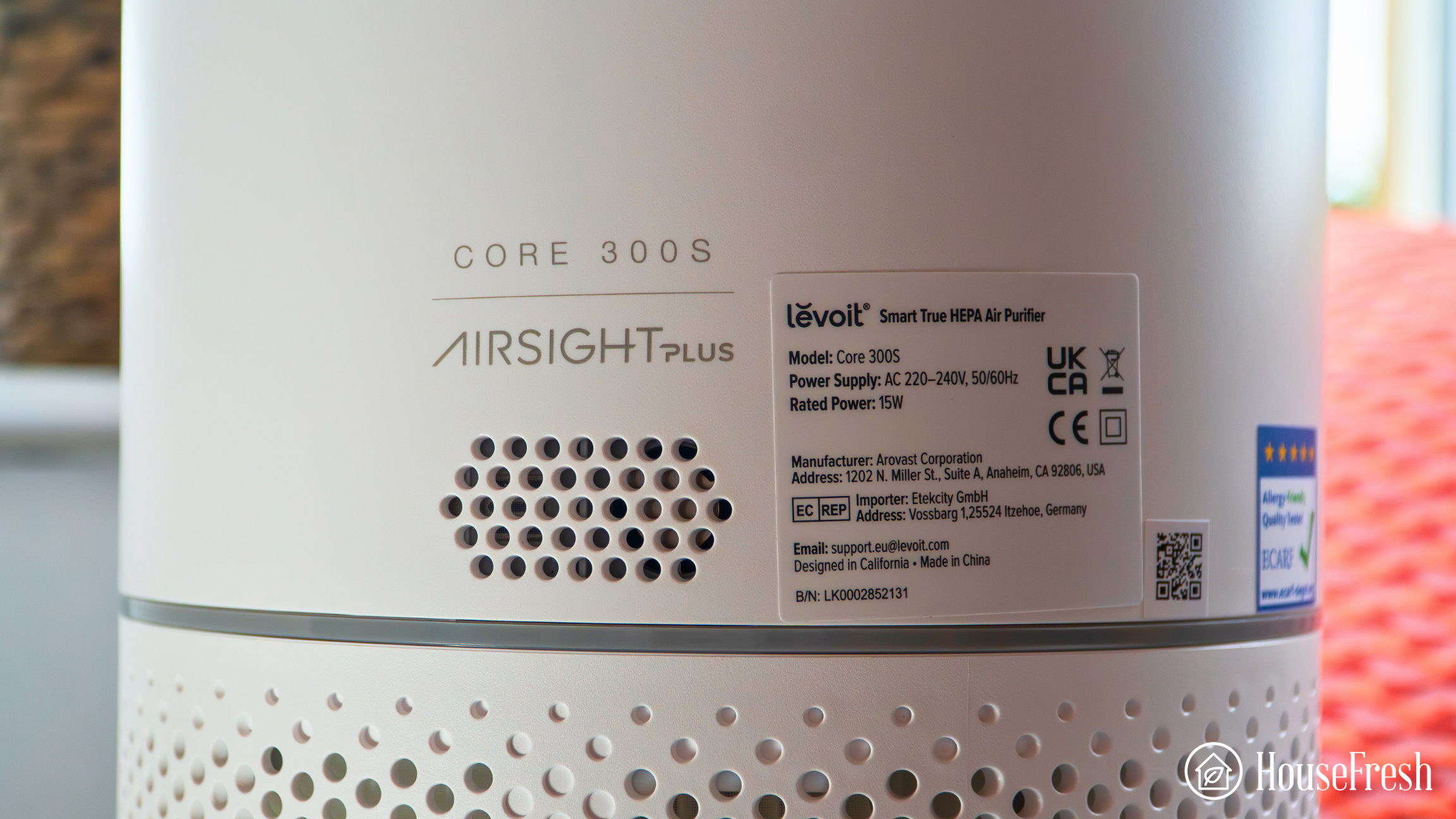

The air quality readings are also uploaded and synced with Levoit’s VeSync app — the next item on this list.
2. Internet connectivity and app support
While the Core 300 doesn’t include smart features, the user-friendly and comprehensive Vesync app enhances the usability of the Core 300S.
Some useful functions include tracking your home air quality and filter lifespan from wherever you are, navigating through mode settings and fan speed and connecting the unit to Google Home, Alexa and Apple Home.
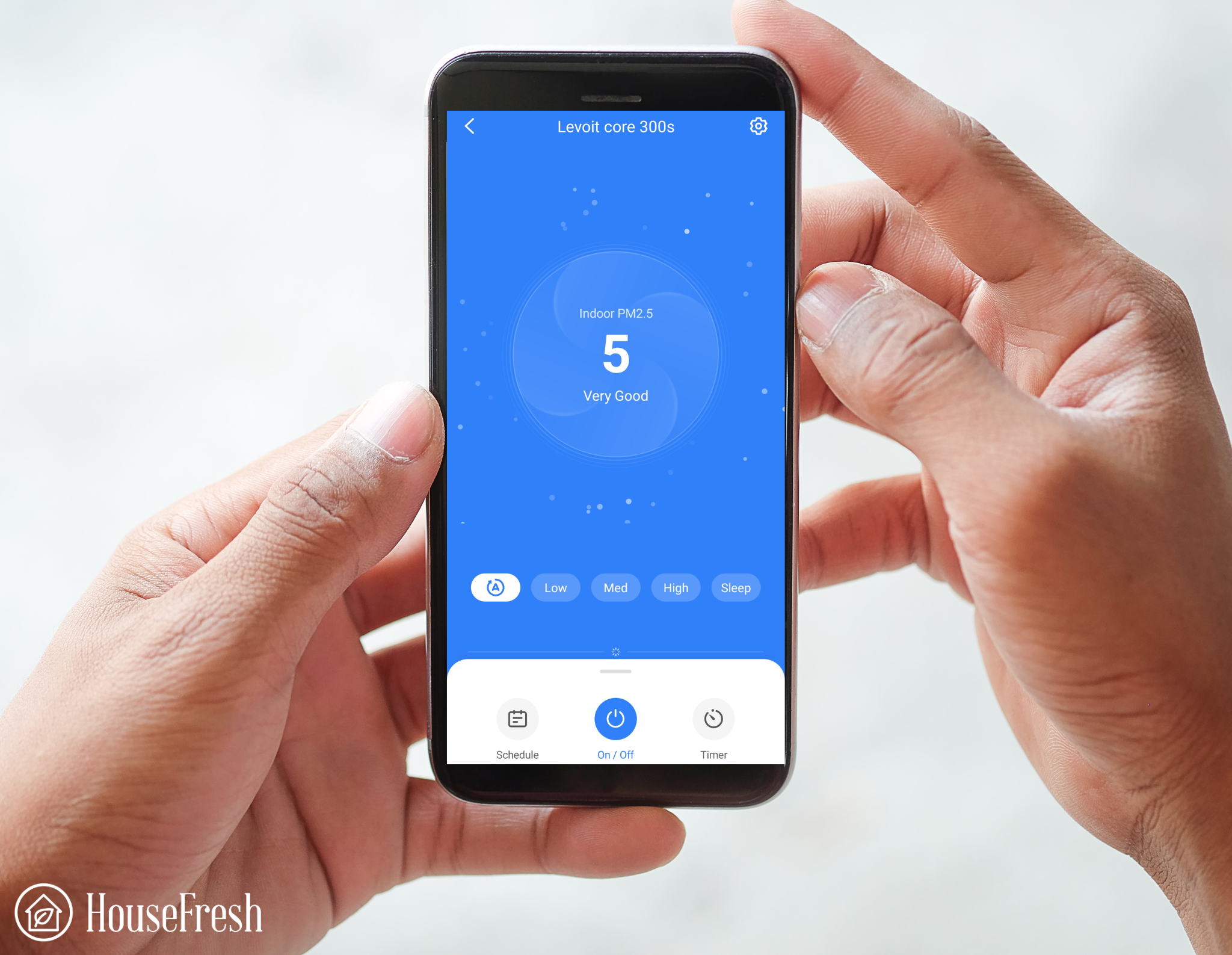
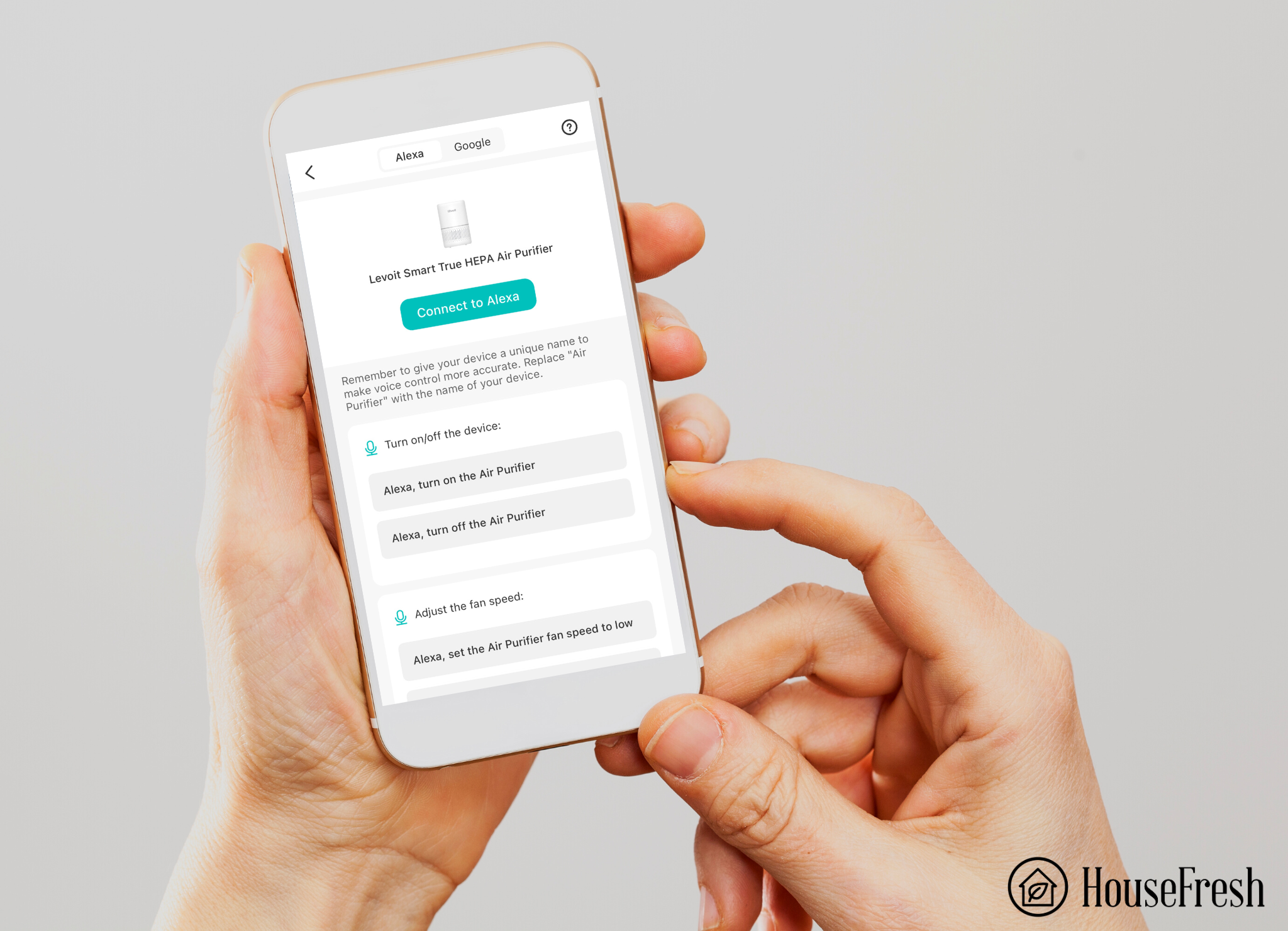
3. Energy costs
To me, this is one of the most significant strengths the Core 300S has when compared to the Core 300. The Levoit team managed a great efficiency improvement achieving a max draw of 26 watts at top speed for the Smart unit. It reduces the yearly cost of running the Core 300S to $27.33 — a whole 40% vs the Core 300.
4. Initial price
Smart features and optimized energy costs do come at a cost. There’s a $50 cost difference between the two models —and so it’s been since the launch of the Core 300S. This may be too pricey for some while, but for others, it will make perfect sense to pay the difference upfront.
Each unit has clear pros and cons. If you would like to probe deeper into these two units’ comparison, read on in our Levoit Core 300 VS Core 300S review.
Bottom line
With a big performance and small price, the Core 300 is a jack-of-all-trades.
There are many things to like about the Core 300; it is the one unit I have no problem recommending year after year. A 145 CADR score makes it reliable and cost-effective, with a fairly quick cleaning speed. It’s also small enough to be versatile and unintrusive, ideal for small kitchens, bedrooms, or even bathrooms.
The sleek control panel is straightforward and easy to navigate. Plus, maintenance is minimal, only requiring a filter replacement twice a year (although you can go the extra mile to keep the unit in top shape).

That being said, if budget is not an issue, I would think about upgrading to the Core 300S, mostly because of its more efficient energy consumption. Or you might want to consider taking it up a notch with the Levoit Vital 200S, which, for less than $200, features a CADR of 245 CFM, HEPA filters and a higher amount of activated carbon.
At the other end of the spectrum, the Winix A230/A231 is below the Core 300’s initial price and features an auto mode. However, it has a more modest control panel and no all-lights-off option.
SOURCES
We calculated energy consumption costs with the help of the Department of Energy’s appliance energy calculator. We calculated yearly costs associated with running the Levoit Core 300 for 24hs a day for 365 days. We ran this calculation utilizing the U.S. average utility rate of $0.12/kWh as of February 1st, 2024.
Last update on 2024-04-19 / Affiliate links / Images from Amazon Product Advertising API



